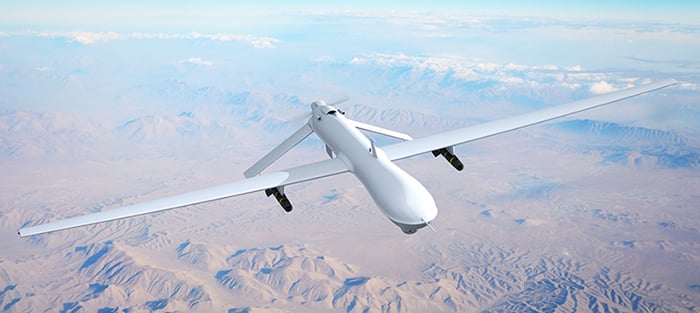
Materion’s advanced materials are used for high-consequence defense missions across multiple domains - missions which cannot fail even under the most demanding of circumstances. Space-based optical systems that detect and track missiles, space-based surveillance, high-altitude UAV surveillance, airborne target acquisition and designation systems, and an interceptor able to defeat an incoming ICBM are all examples of defense needs that are enabled by Materion’s beryllium-containing materials. While other, more common, metals can be used in these applications, they may not perform consistently in high-pressure conditions, failing when they are needed most. For exceptional, dependable results, an advanced material may be the best solution.
The use of Materion’s beryllium-containing materials in defense generally falls into one of four broad categories:
During this discussion I am going to focus on reflective optical systems. This includes applications for space-based systems, airborne platforms, missile seekers and even a few ground-based systems. Here are some of the properties that are of interest to reflective optical system designers and why they are important:
Other factors influencing material selection include material availability, lead-time, size and product forms, manufacturability, the material optical system heritage and the ever-present reality that cost is an important consideration. But cost must always be considered in terms of the total cost and the value provided.
Materion offers some very good material solutions for reflective optical systems that address the required properties discussed above. Beryllium metal offers a solution for the most demanding applications, having the highest specific stiffness of any metal (specific stiffness is the ratio of stiffness to density), which addresses both 1 and 2 above. The HIP (Hot Isostatically Pressed) and CIP (Cold Isostatically Pressed) product forms are highly isotropic with a relatively low CTE and these materials have excellent dampening properties. A bare polished beryllium surface is highly reflective for IR wavelengths, but for other wavelengths the reflective optical surface is achieved through a nickel-plated layer. (Note that the optical coating really determines UV-IR reflectance performance. It is rare that bare Be or Ni would be used as the final optical surface.)
Ni plate onto beryllium substrates is widely used but requires care to control Ni thickness and to balance the Ni front to back to avoid bi-metallic distortion. There is a lot of heritage for these types of beryllium mirrors, and they are used for space-based, airborne and ground-based systems with good results. Ni plated beryllium mirrors are also used for very demanding missile seeker applications.
|
I-70H |
||
|
Density lb/in3 (g/cm3) |
0.067 (1.85) |
|
|
Modulus mpsi (Gpa) |
44 (303) |
|
|
Ultimate tensile strength kpsi (MPa) |
50 (345) |
|
|
Yield strength kpsi (MPa) |
30 (207) |
|
|
Elongation % |
2 |
|
|
Thermal conductivity (Btu-hr-ft-oF (W/m-K) |
125 (216) |
|
|
Heat Capacity, Btu/lb-oF (J/g-K) |
0.46 (1.93) |
|
|
CTE ppm/oF (ppm/K) |
6.3 (11.2) |
I-70-H is often selected for reflective mirrors but there are several different beryllium metal grades and different product forms.
There will be applications that do not need the superb performance provided by beryllium metal, and for those systems we can offer some other material options. AlBeMet® AM162-H is a high-performance metal matrix composite of aluminum and beryllium metal. It offers slightly lower properties than pure beryllium but at a reduced cost and with improved manufacturability. AlBeMet also has a better match of CTE to electroless nickel plating than beryllium for mirror applications. Materion also produces an aluminum beryllium material composition known as AlBeCast® that can be investment cast into precision structures suitable for metering of AlBeMet mirrors for airborne and space applications.
|
AM162H |
||
|
Density lb/in3 (g/cm3) |
0.076 (2.1) |
|
|
Modulus mpsi (Gpa) |
28 (193) |
|
|
Ultimate tensile strength kpsi (MPa) |
38 (262) |
|
|
Yield strength kpsi (MPa) |
28 (193) |
|
|
Elongation % |
2 |
|
|
Fatigue strength ksi (MPa) |
18 (124) |
|
|
Thermal conductivity (Btu-hr-ft-oF (W/m-K) |
121 (210) |
|
|
Heat Capacity, Btu/lb-oF (J/g-K) |
0.373 (1.56) |
|
|
CTE ppm/oF (ppm/K) |
7.7 (13.9) |
|
|
Electrical conductivity (%IACS) |
45 |
For some reflective optical systems AlBeMet properties are more than what is needed, but the designer may want properties better than a high-quality aluminum alloy can offer. Here, our SupremEX® family of metal matrix composites may be the right fit. They offer a balanced combination of ultrafine silicon carbide reinforcement with aerospace aluminum alloys. The result has the lightweight properties of aluminum with outstanding strength and stiffness, making it superior to conventional alloys. To learn more visit our SupremEX product page.
The team at Materion has many years of materials knowledge and we understand the challenges of applying manufacturing processes to produce stable optical systems. We can provide advice on reducing residual stress, thermal stabilization, joining techniques and offer advice on protective coatings for our materials. If you have any questions, please ask – our specialty is coming up with custom solutions for unique use cases. Connect with me on LinkedIn.